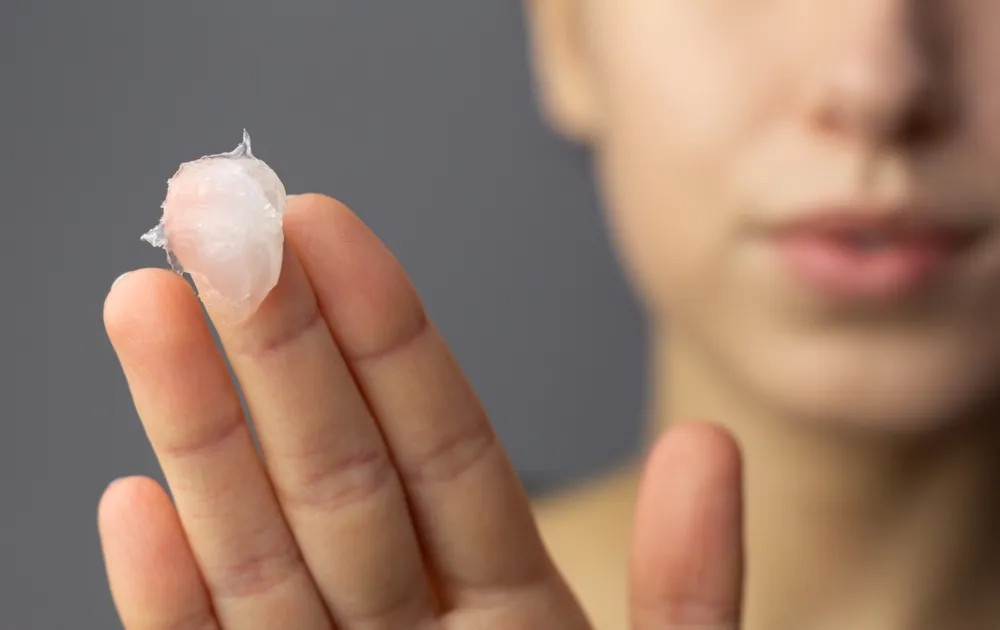As the cold weather sets in, our skin often starts to show the effects — dry, flaky, lackluster. Fortunately, skin slugging could be the hydration boost those battling winter skin woes need. This skincare method has gained popularity for its potential to lock in moisture during the harshest months. If you’re ready to transform your cold-weather beauty routine, here’s everything you need to know about skin slugging.
 Shutterstock: Anna Gawlik
Shutterstock: Anna GawlikWhat Is Skin Slugging?
Skin slugging is a method that involves applying an occlusive layer, like petroleum jelly, as the last step in your nighttime skincare routine. This technique doesn’t add moisture to the skin but can help prevent moisture loss. Many people who practice slugging believe it works best when done on clean skin, ideally over a light layer of moisturizer. For those dealing with dry or sensitive skin, slugging could offer a way to lock in hydration overnight, giving the skin a smooth, plump appearance by morning.
Moisturize, Protect, Repair
The concept behind slugging revolves around helping the skin maintain moisture while protecting its barrier. Slugging may work best when combined with a good moisturizer underneath, which provides initial hydration before the occlusive layer seals it in. This technique could give the skin a better chance to repair itself overnight by creating a protective layer against potential environmental factors. While slugging isn’t for everyone, some find it beneficial in keeping dryness at bay and allowing products applied underneath to work more effectively.
Why Is It Called Slugging?
After applying a thick layer of petroleum-based product, your skin resembles the slick, shiny texture of a slug’s trail — hence the name. While it might sound strange, this visual comparison highlights the main function of slugging: to create a smooth, occlusive layer that locks in moisture. This barrier can be especially effective in cold weather, helping to combat dryness by sealing in your other skincare products overnight.
How Skin Slugging Works
Slugging forms a seal on the skin’s surface, which reduces the amount of water lost through the skin overnight. It could help those with dry or compromised skin barriers by keeping the hydration from earlier steps close to the skin. Because petroleum-based products don’t actually absorb deeply, they may work by preventing the evaporation of products layered beneath. This process may seem simple, but it’s essential to understand that slugging is about trapping moisture rather than adding it. Depending on your skin’s needs, this extra step could enhance the hydration and effectiveness of your skincare.
Benefits of Skin Slugging
Many people believe slugging brings a noticeable glow to the skin, possibly due to improved hydration and barrier support. Skin may appear softer and more supple after a night of slugging, especially in cases of dryness or dehydration. This technique can also act as a buffer against environmental irritants, as the occlusive layer may reduce exposure while you sleep. For those with specific skin conditions like eczema or extremely dry skin, slugging might provide relief from irritation and prevent moisture loss, but it’s always wise to test it first if your skin is sensitive.
Slugging Products
Choosing the right product for slugging is key. Vaseline, Aquaphor, and CeraVe Healing Ointment are popular options. Vaseline, with pure petroleum jelly, can create a complete occlusive barrier to keep moisture locked in. Aquaphor, on the other hand, contains a blend of petroleum and soothing ingredients. It may appeal to those who want a slightly lighter feel. CeraVe Healing Ointment includes ceramides, which could provide extra support for the skin barrier. Pure petroleum — or close to pure — is often recommended for slugging because it’s highly effective at preventing water loss and generally considered safe for most skin types.
Discover Radiant Winter Skin With Slugging
Slugging is worth exploring for those looking to boost their skincare routine. The technique can offer a range of benefits, from enhanced moisture retention to increased skin smoothness. Whether you’re tackling dry patches or simply aiming for a healthier-looking complexion, this simple practice can support your skincare goals. Of course, it’s always wise to try new skincare techniques on a small area first to see how your skin responds. Always listen to what your skin needs!
